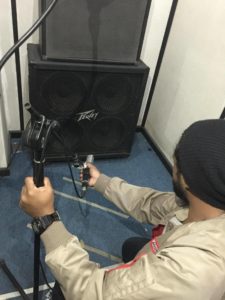There are several things we aware in music production. Why there’s still many people being skeptical on amp simulator quality while amp simulators aren’t that widespread in use compared to software synthesizers, which are becoming more common nowadays with countless hits made solely using software. We gather five strong reasons why you should start considering using software amp simulator for recording guitars. We assure you’ll become much positive and happier guitarists after reading this article. So, read on!
No.1: Accessibility and Convenience
This only reason is the best one. There’s a saying that people will pay gold for convenience. Except for this one, you only need to pay a small fee for a convenience that will last forever on amp simulators.
No need to do extra work setting up the mics, cabinets, amps, guitars, and extra cables. You won’t disturb the neighbour with a cranked up gain on the amp. No need for extra space. And just in case you desperately need a specic tone from a specific amp you can simply download one

Best cellphones of 2006.
No.2: Never going into a debate into such “digital vs analog” topics again.
It’s irrelevant anymore. It’s like going back to 10 years ago where digital technology are starting to take control of everything. Are you still using Nokia or something? Yeah it’s true that there is no Modelling technology that has come close to a cranked 100 watt tube amp… Yes nothing matches the sweet dynamic response of real tube saturated and glowing rather than the amp simulators showing in your screen (no glowing tubes). But hey, let’s move on guys… We all agree that the Real ones are definitely better, but people loves digital technology because it’s convenient, sometimes it’s better than the real thing, and nothing better than to stalk your ex through the social clouds. So stop debating, and start doing what matters the most: your music!
No.3: We love to become contrasting  . In this vast digitised world we live in, let’s not forget the history and implement those secret ancient methods within the digital domain.
. In this vast digitised world we live in, let’s not forget the history and implement those secret ancient methods within the digital domain.
The good old-fashioned methods are still a tried-and-true practice which shaped our culture. Learn and experience how the “real thing” works so you can understand the reference and make the most from your amp modeling softwares. Because hey… Amp Simulators are modeled after the real analog counterparts right? So the ultimate goal is too make everyone’s convinced that you are going all analog on your newest album, it’s cool and indie and geeky and those hipsters will admire you.

Miking a “real” amp
Understand why you need to use the virtual microphones to find the sweet spot, understand what best cabinet IRs to choose from a specific tone, make sure that the dynamic response your strings are articulated enough, learn which frequencies needs to be tamed or boosted for guitars, understand each of the strength between a solid state vs tube amp, and figure out why an amp’s dropping voltage “sound” a.k.a. sag is important in recreating that great tone.
No.4: CPU processing power is increasing exponentially while becoming cheaper every year.
Know about Moore’s Law. In 1965, Gordon Moore made a prediction that would set the pace for our modern digital revolution. From careful observation of an emerging trend, Moore extrapolated that computing would dramatically increase in power, and decrease in relative cost, at an exponential pace. By that logic, imagine how much power fueling Digital Audio Workstations, numerous vst plug-ins and/or amp simulators running in your computer.
Think how’s computers become in-the-box solution for whole music production, from recording to mastering to live performance. It’s becoming more powerful throughout the years, but why you still craving for a hardware upgrade every year? software developers like us are always keeping pace with the newest hardware performance, thus utilising every single cycles of the processing juice to emulate every small details occurred on an amp circuit to make the best amp simulators which can be as accurate as possible compared with the real ones.
No.5: The Pros are also already using amps simulators as their weapon of choice.
In 1998, Line 6’s Amp Farm® TDM plug-in was available only for ProTools users. But, the computers technology started to grow faster than ever due to the reason above, in no time, the technology have fundamentally changed the of playing (small practice amp) and recording. In live situations, many trusted their live guitar rig using in-the-box solutions like Kemper KPA or Axe-FX which basically also utilising DSP chips which in principal similar with CPU-based plug-in amp simulators or guitar amp softwares.
What is the reason? it’s more affordable, practical, lightweight, easy to set-up, you can always update and tweak your sound on the spot, and comparable in sound quality compared with a full-force live guitar rig. Those are the main reason why the audiences pays large sums of money to watch your concert: to solely entertain them with your sound. By using amp simulators, basically, you can have a streamlined set-up with lesser time, less hassle between your home > studio > live situation with consistent results. Thus, milder headache for your guitar technician so they can perform much better in every session with you.


